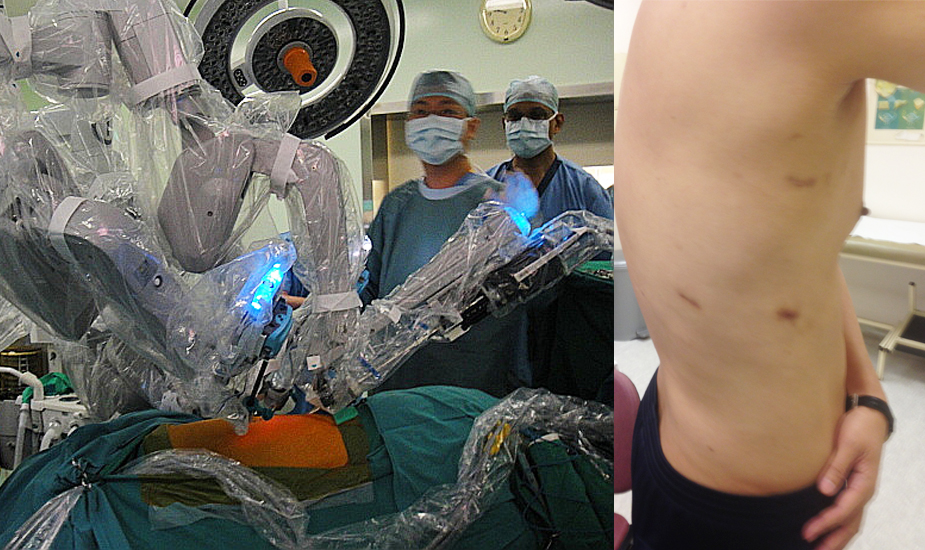THORACIC & MINIMALLY INVASIVE THORACIC (Lung) SURGERY
Making recovery faster for patients
Lung Cancer (primary/secondary) (Read More about Lung Cancer Screening)
- Minimally Invasive approach / Video-assisted thoracoscopic surgery including Uniport (single hole) VATS approach
- Lobectomy
- Bilobectomy
- Wedge resection/metastesectomy
- Segmentectomy
- Pneumonectomy
- Extrapleural Pneumonectomy
- (Mesothelioma Stage 4A thymoma)
- Robotic-assisted resection
Mediastinal Tumor Surgery
- Thymectomy, neurogenic tumor, leiomyoma– VATS (Including Uniport) approach
- Clamshell
- VATS biopsy
- Chamberlain procedure
Mediastinal Lymph Node Surgery (VATS, including Uniport approach)
- VATS biopsy
- VATS clearance
Lung Biopsy (VATS)
- Nodule resection
- Diagnostic
- Interstitial Lung Disease
- Infection
- Malignancy
Pleural Surgery (Uniport VATS)
- Pleurodesis
- Pneumothorax
- Pleural effusion
- Chylothorax
- Pleural biopsy
- PleurX catheter insertion
Infection (VATS, including Uniport approach)
- Decortication
- Lung abscessdamage
- Lung resection
Chest Wall Surgery
- Resection & reconstruction
- Infection
- Tumor
- Pectus excavatum repair
- Nuss procedure
- Ravitch procedure
Mediastinoscopy
- Cancer Staging
- Diagnosis
- Tuberculosis
- Sarcoidosis
- Lymphoma
- Other Malignancies
Chest Trauma
- Emergent room thoracotomy
- VATS evacuation of hemothorax
Lung Failure Surgery
- Lung volume reduction surgery (LVRS)
- Veno-venous ECMO therapy
Diaphragm
- Repair
- Plication for diaphragmatic paralysis
The traditional approach for a surgeon to gain access to the chest involves performing a 10-15 cm incision (cut) on the chest. This remains the standard in certain thoracic conditions including lung cancer surgery. However, it is invasive as it involves a large incision and rib spreading. And despite being the most common approach, it may give the patients more chest trauma, pain, and slower return to baseline activities.
On the other hand,Video-Assisted Thoracoscopic Surgery (VATS) is an advanced form of an alternative approach and a minimally invasive lung surgery which allows trained thoracic surgeons to achieve the same goal as thoracotomy. Through one to three small incisions (measuring 5-12 mm each), this type of thoracic surgery enables the surgeon to view the whole chest cavity with a small video camera. The images are then projected onto a high-resolution computer monitor. In our centre, it is routinely used to perform diagnostic procedures such as lung, pleura, mediastinal lymph nodes, and tumors biopsy. It further allows our surgeons to safely carry out treatment of most of the thoracic surgery as follow:
Pleurodesis
- Pneumothorax (air in chest cavity)
- Pleural effusion (fluid in chest cavity)
- Chylothorax (lymphatic fluid in chest cavity)
Decortication of empyema
Lung volume surgery for severe emphysematous lungs
Resection of mediastinal tumors
- Thymoma
- Neurogenic tumor
- Bronchogenic cyst
- Leiomyoma
Lung cancer Surgery
- Wedge resection (usually for secondary cancer spread from other organs)
- Segmentectomy
- Lobectomy
Esophagectomy for esophageal cancer
Sympathectomy for sweaty palms and/or sweaty armpits
Drainage of hemothorax (blood in chest cavity)

With small incisions and non-rib spreading techniques, VATS offers numerous benefits, including less pain after an operation, early mobilization, better immune response, and earlier return to normal activities.
As technology continues to evolve and a better understanding of minimally invasive lung surgery techniques by our surgeon, Dr Su has now utilized Uniport VATS approach for many of his thoracic surgery. These include lung cancer surgery such as lobectomy or segmentectomy, mediastinal tumor resection and many thoracic surgical conditions as listed above. Through a 2-4 cm incision, the whole surgery will be completely by an experienced and trained hands. This translates to much less pain after surgery, coupled with shorter hospital stay, earlier return to normal activities and certainly lesser cost. Being one of the most experienced cardiothoracic surgeon, Dr Su ensures his patients the best surgical experience without compromising safety and oncological principles.
